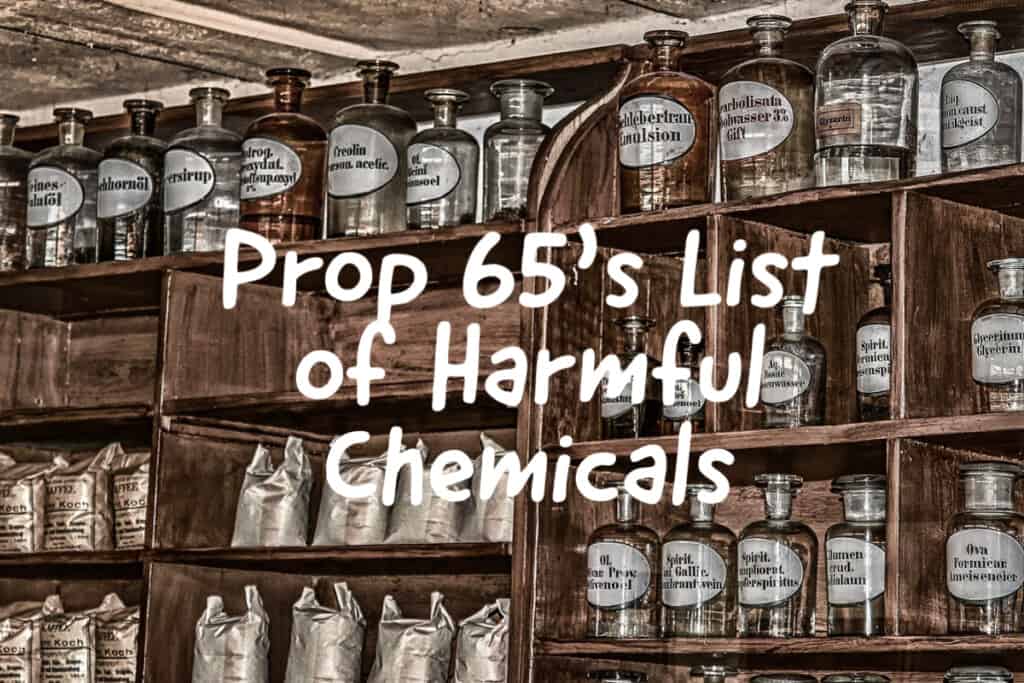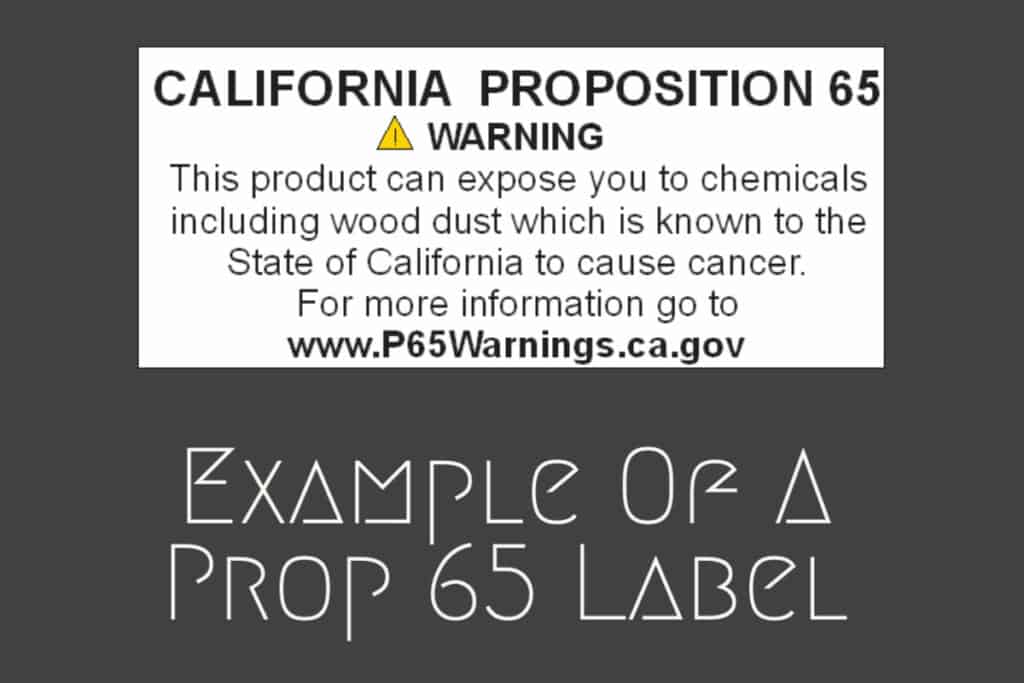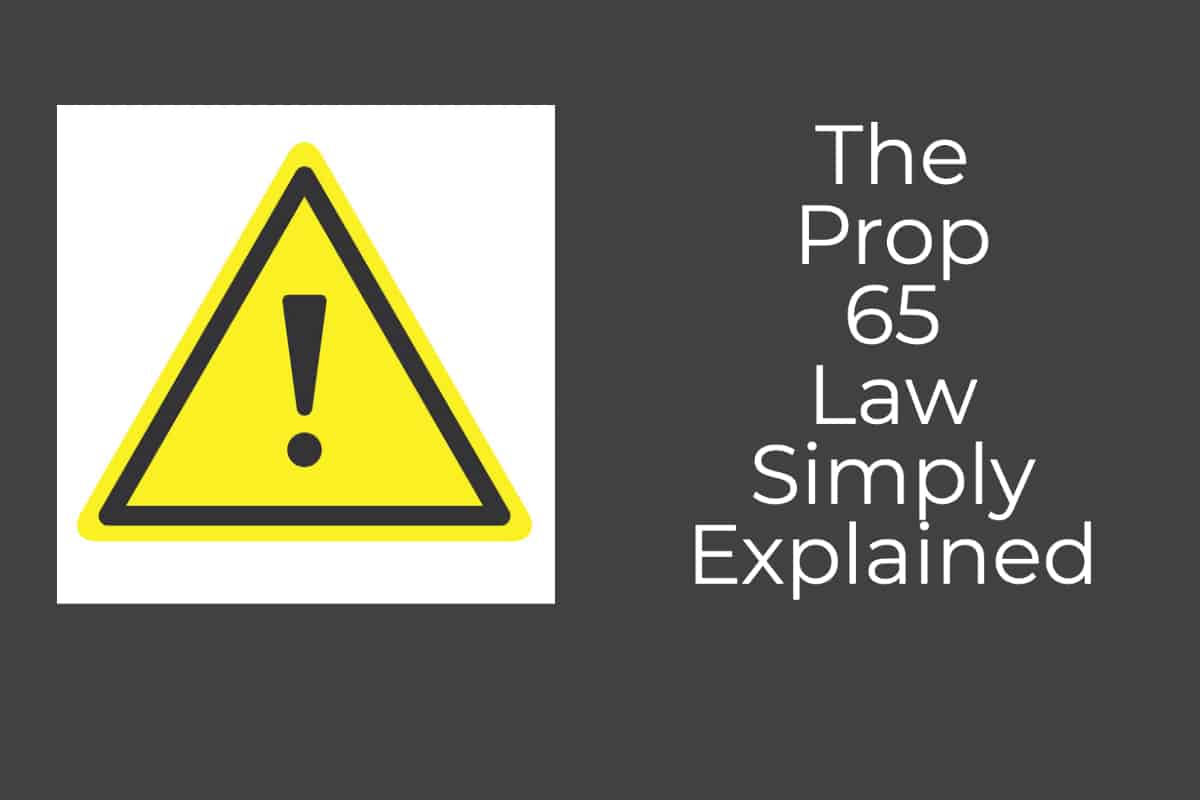Today when you purchase many items in the United States, you will see a label that will warn you that this item “can expose” you to certain harmful chemicals. This warning label is known as the Prop 65 label.
The Prop 65 warnings affect all consumer products that are sold or distributed in the State of California; it is a consumer “right-to-know” law that warns that certain chemicals can harm your health. The Prop 65 law requires that the State of California publish and list all chemicals known to cause cancer, reproductive toxicity, or harm.
Table of Contents
- The Prop 65 Law
- What does The Prop 65 warning mean?
- The Prop 65 Warning Labels
- Should You Worry About The Prop 65 Warnings?
- Related Questions
The Prop 65 Law
Prop 65 is a California state law that is a “right-to-know” law. “Right-to-know” is a legal term that means individuals have the “right to know” what chemicals they may be exposed to during their daily lives. The official Prop 65 law was the “Safe Drinking Water and Toxic Enforcement Act of 1986.”
The Prop 65 law is similar to many “right-to-know” laws that are in place throughout the United States, Europe, and most of the world. The difference with the Prop 65 “right-to-know” law is that this is a consumer, not a workplace “right-to-know” law.
The Prop 65 law requires that the State of California publish and list all of the chemicals known to cause cancer, reproductive toxicity, or harm. In other words, this law is about the right of a consumer to understand that the products they are purchasing “can” cause them harm or “can expose” them to harmful chemicals.
The operative word here is “can.” Prop 65 does not say the chemicals “will” or “do” cause harm but instead that these chemicals “can” cause harm. This is where it can confuse many people as to why a label must be put on a product that “can expose” you or “can” cause you harm. The Prop 65 right-to-know” law is set in place to warn you that a chemical “can expose” or “can” harm you so you can make your own decision on the matter.

Prop 65 Harmful Chemical List.
Prop 65 publishes a list of over 900 chemicals that can be harmful. The law really does not take a stance on these chemicals because the Prop 65 law does not ban or restrict the chemicals on their list.
Instead, the list is meant to guide California residents to make an informed decision about their own health and safety and decide whether or not they want to have the products in their homes. You can find the complete list of the Prop 65 harmful chemicals here.
Prop 65 affects all consumer products that are sold or distributed in the State of California. The products Prop 65 affects include textiles, footwear, hard goods, DIY products, toys, juvenile products, stationery, electrical products, and electronics; it also affects some food, cleaning products, and many other products. In short, it affects almost any item, including home decor and home furnishing products, sold or distributed within California.
What does The Prop 65 warning mean?
The Prop 65 warning, also known as Proposition 65, is, as it says, a warning. It does not mean that the item you are purchasing will be harmful to your health because all the Prop 65 warning is saying is that the product can be harmful to your health.
Many people are confused about exactly what that Prop 65 sticker on the product they are buying means. If they refused to purchase anything with a Prop 65 sticker, their buying choices would be significantly limited.
You can equate the Prop 65 warning to someone warning you that there is a bump on the road ahead. This person may warn you and tell you to watch out for that bump in the road as it “can” hurt your car. So you slowly drive down the road only to learn that the bump they were warning you about was small; you did not even feel the bump as you were driving down the road.
The Prop 65 labels warn you this product could be harmful, but it doesn’t necessarily mean that it will be harmful to your health. Under Prop 65, a seller or distributor must warn the consumer if they want to sell the product anywhere in the State of California. If the product was being sold in another state like Nevada, Texas, or Wisconsin, a Prop 65 label is not required.
Most manufacturers and sellers will put the Prop 65 label on all the products they sell or distribute in the United States; they can not be sure if the product they are selling or distributing will eventually ends up for sale in the State of California, where the Prop 65 label is legally required.
In fact, today, most Asian manufacturers understand they cannot sell harmful products or any products that have any liability associated with them. This is why at Mondoro, we will test and carefully check the quality of the products and the vendors we are working with.
The Prop 65 Warning Labels
Today many products have Prop 65 warning labels on them. In fact, these labels are so common that most consumers do not really see them on the products.

Before August 2018, the Prop 65 labels could say that the chemicals were present. They did not need to state an actual chemical or give specific information on how they can be exposed to the chemical.
After August 2018, the Prop 65 labels, which are also called “safe harbor warnings,” changed as follows:
- “Can expose you” – The new warning for consumer products needs to say that the product “can expose you to.”
- Listed Chemical – At least one chemical must be listed on the new labels. You can find the list of chemicals on the Prop65 website by clicking here.
- List Exposure Risk – You need to list if the specific chemical exposure risk can cause cancer and/ or cause birth defects or other reproductive harm.
- Website – The Prop65 website (www.P65Warnings.ca.gov) must be listed on all labels.
- Yellow Triangle – A Triangle yellow warning symbol must be on the warning label.
Should You Worry About The Prop 65 Warnings?
As a manufacturer, I cannot tell you not to worry about the Prop 65 warning label as they are put there by the State of California for a specific reason and purpose. But what I can tell you is that Mondoro, like everyone else, spends a lot of time testing and checking out products to make sure that they are all up to standard.
I believe the New York Times and Wirecutter said it best when they wrote this about the Prop 65 warning labels:
“The Prop 65 label is like a noisy alarm that rings equally loudly about smaller amounts of low-risk substances and huge amounts of potentially harmful chemicals. The labels don’t say how much of the chemical is present, or how much it would really take to make a person sick. You could get the same alarming label on potato chips (acrylamide), chemotherapy (uracil mustard), lumber (wood dust), or toxic runoff (arsenic). It’s obviously helpful to be alerted to the presence of potentially harmful chemicals. But not all doses of these different chemicals mean the same thing.”
Wirecutter
In other words, Prop 65 does not tell you any of the substances they have listed are in any large amount or that they will personally cause you any harm in any way. It is as the label says – just a warning.
Anyone looking to sell, distribute, export, or import products into the United States needs to understand the Prop 65 law and what it means to sell their products into the United States market. If you still have some questions, you can also check out the Prop 65 website by clicking here.
If you are looking for a reliable partner in Asia, we would love to hear from you. At Mondoro, we create, develop, and manufacture home decor and home furnishing products. Feel free to contact me, Anita, by clicking here or to write me directly via my email by clicking here.
Find out more about how Mondoro can help you create, develop, and manufacture excellent home decor and home furniture products – don’t hesitate to contact me, Anita. Check out my email by clicking here or become a part of our community and join our newsletter by clicking here.
Mondoro gives out a FREE Lookbook to anyone interested. You can receive a copy of our latest Lookbook by clicking here.
Listen to our Podcast called Global Trade Gal. You can find it on all major podcast platforms. Try out to listen to one of our podcasts by clicking here.
Subscribe to our Mondoro Company Limited YouTube Channel filled with great videos and information by clicking here.
Related Questions
What Is The Difference Between Product Sourcing and Procurement?
Product sourcing is about obtaining or purchasing a product for your supply chain needs. Product procurement is the process that is put in place for the entire product, including sourcing, purchasing, and delivery of the product.
You can learn more by reading our blog Supply Chain Differences: Product Sourcing vs. Product Procurement by clicking here.
How Do Courier and Air Freight Companies Charge By Volume and Weight?
Air Freight companies will use both the volume or size and the weight of a package to come up with the volumetric weight. If the package is lighter than the actual volumetric weight, the volumetric weight will be charged. If it is heavier than the volumetric weight, then the actual weight of the package will be charged.
You can find out more by reading our blog How Courier and Air Freight Companies Charge By Volume and Weight by clicking here.

